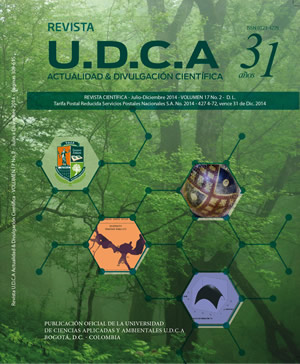Factors that affect colony forming units in bulk milk of north Antioquia-Colombia dairy farms
Factores que afectan el recuento de UFC en la leche en tanque en hatos lecheros del norte de Antioquia-Colombia
Main Article Content
Abstract
In Antioquia-Colombia, the primary milk production is mainly performed at the northern "altiplano" region using both manual and automatic milking systems. The product quality will define its commercialization directly to consumers after pasteurization or for processing and derivates production. In both cases, the initial microbial contamination is crucial for its final use. Colombian regulations, specific for regions, define the allowed values of colony forming units (CFU), so the producers not only can sell their production, but also obtain important price bonus. The objective of the present work was to study some factors that can affect the bulk milk CFU counts in northern Antioquia dairy farms. The dependent variable was measured, described with an unvaried analysis and associated with a logistic regression. CFU, and independent variables as milking system, altitude, milking time in churn (minutes), distance to bulk (m) and cow number were measured, analyzed and associated with univariated and logistic regression statistics. Results indicated that the main risk factor in the CFU variation was 148 the time period that the milk remained out of the cold chain. Other critical factors were the number of milked cows, since it increases the milking time; equally, altitude where farms are located, possibly related to temperature and bacterial proliferation.
Keywords:
Downloads
Publication Facts
Reviewer profiles N/A
Author statements
- Academic society
- Universidad de Ciencias Aplicadas UDCA
- Publisher
- Universidad de Ciencias Aplicadas y Ambientales U.D.C.A
Article Details
References (SEE)
CALVINHO, L. 2001. Diagnóstico bacteriológico de mastitis y su importancia en los programas de control. Disponible desde Internet en http://www.aprocal.com.ar/wp-content/uploads/diagnostico_ de_mastitis.htm.pdf (Brasil) (con acceso 2/09/2011).
ELMOSLEMANYA, A.; KEEFEA, G.; DOHOOA, I.; WICHTELA, J.; STRYHNA, H.; DINGWELLE, R. 2010. The association between bulk tank milk analysis for raw milk quality and on-farm management practices. Prev. Vet. Med. (Irlanda). 95:32-40.
GALTON, D.; PETERSSON, L.; MERRILL, W. 1986. Effects of premilking udder preparation practices on bacterial counts in milk and on teats. J. Dairy Sci. (USA). 69:260-266.
GAVIRIA, B. 2007. Calidad higiénica y sanitaria de la leche cruda. En: Buenas prácticas de producción de leche. Ed. Biogénesis, Universidad de Antioquia (Medellín-Colombia). 189p.
GONZALO, C.; CARRIEDO, J.A.; GARCIA-JIMENO, M.C.; PEREZ-BILBAO, M.; DE LA FUENTE, L.F. 2010. Factors influencing variation of bulk milk antibiotic residue occurrence, somatic cell count, and total bacterial count in dairy sheep flocks. J. Dairy Sci. 93:1587-1595.
MADR-COLOMBIA. 2007. Pago de leche cruda al productor. Ministerio de Agricultura y Desarrollo Rural. Resolución 000012, 2007.
MORSE. P.M.; JACKSON, H.; MCNAUGHTON, C.H.; LEGGATT, A.G.; LANDERKIN, G.B.; JOHNS, C.K. 1968a. Investigation of factors contributing to the bacterial count of bulk-tank milk. I. Influence of two-day storage and effect on results of preliminary incubation. J Dairy Sci. 51:1182-1187.
MORSE, P.M.; JACKSON, H.; MCNAUGHTON, C.H.; LEGGATT, A.G.; LANDERKIN, G.B.; JOHNS, C.K. 1968b. Investigation of factors contributing to the bacterial count of bulk tank milk. II. Bacteria in milk from individual cows. J Dairy Sci. 51:1188-1191.
MORSE, P.M.; JACKSON, H.; MCNAUGHTON, C.H.; LEGGATT, A.G.; LANDERKIN, G.B.; JOHNS, C.K. 1968c. Investigation of factors contributing to the bacterial count of bulk tank milk. 3. Increase in count, from cow to bulk tank, and effects of refrigerated storage and preliminary incubation. J. Dairy. Sci. 51:1192-1206.
POSADA ARIAS, S.; LOAIZA, E.; RESTREPO, J.; OLIVERA, M. 2010. Caracterización del ordeño manual e identificación de puntos críticos de control para la calidad higiénica de la leche en una finca del norte de Antioquia. Rev. Lasallista Invest. (Colombia). 7:35-46.
RAMÓN ESTÉVEZ, J.; RESTREPO BOTERO, J.; RUIZCORTÉS, Z.; OLIVERA ÁNGEL, M. 2011. Detección de riesgos de contaminación con microbios ambientales en un sistema de ordeño mecánico de un hato lechero del norte de Antioquia. Rev. Lasallista Invest. 8:7-15.
SIERRA, D.; SÁNCHEZ, A.; CONTRERAS, A.; LUENGO, C.; CORRALES, J.C.; DE LA FE, C.; GUIRAO, I.; MORALES, C.T.; GONZALO, C. 2009. Short communication: effect of storage and preservation on total bacterial counts determined by automated flow cytometry in bulk tank goat milk. J. Dairy Sci. 92:4841-4845.
VAN SCHAIK, G.; GREEN, L.E.; GUZMAN, D.; ESPARZA, H.; TADICH, N. 2005. Risk factors for bulk milk somatic cell counts and total bacterial counts in smallholder dairy farms in the 10th region of Chile. Prev. Vet. Med. (USA). 67:1-17.
VILAR, M.; RODRIGUEZ OTERO, J.; SANJUAN, M.; DIEGUEZ, F.; VARELA, M.; YUS, M. 2011. Implementation of HACCP to control the influence of milking equipment and cooling tank on the milk quality. Trends Food Sci. & Techn. (UK). 20:1-9.
WHO/FAO. 2008. Codex Alimentarius. Animal food production. World Health Organization and Food and Agriculture Organization of the United Nations.
ZENG, S.; ESCOBAR, E. 1996. Effect of breed and milking method on somatic cell count, standard plate count and composition of goat milk. Small Rum. Res. (USA). 19:169-117.







